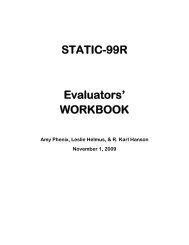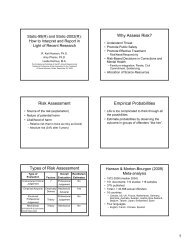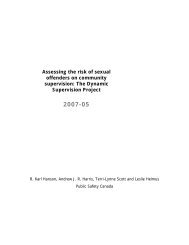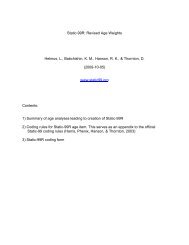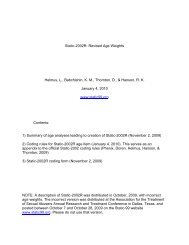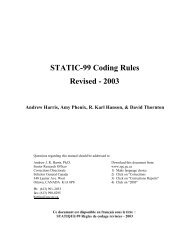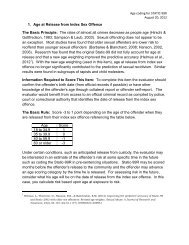Static-2002 coding rules (2009) - Static-99
Static-2002 coding rules (2009) - Static-99
Static-2002 coding rules (2009) - Static-99
You also want an ePaper? Increase the reach of your titles
YUMPU automatically turns print PDFs into web optimized ePapers that Google loves.
- Balance of Probabilities (a.k.a., Preponderance of Evidence). This is the<br />
lowest standard. It is common in civil cases and basically means<br />
“more likely than not,” or at least 51% certainty.<br />
- Clear and Convincing Evidence (a.k.a., Clear and Convincing Proof).<br />
This less-common and infrequently used standard has a higher<br />
threshold than Balance of Probabilities, but it is not quite as<br />
stringent as Beyond a Reasonable Doubt.<br />
There are two general types of decisions involved in scoring <strong>Static</strong>-<strong>2002</strong>. The<br />
first involves whether something counts as a sentencing occasion (Items 2, [4], 5,<br />
11, and 14). Generally, a sentencing occasion requires a criminal conviction or its<br />
equivalent (which is subject to the Beyond a Reasonable Doubt standard). Some<br />
“findings of guilt” occur outside the criminal justice system (e.g., priests, military)<br />
and special <strong>rules</strong> apply (see pages 29-36); minimally, the Clear and Convincing<br />
Evidence standard should be met. Decisions based on a Balance of Probabilities<br />
are generally insufficient to be counted as a sentencing occasion.<br />
Aside from the issue of whether something “counts” as a sentencing occasion, all<br />
other <strong>coding</strong> decisions are subject to the Balance of Probabilities standard (e.g.,<br />
Is this victim a stranger? Was this offence sexually motivated? Would this<br />
behavior be subject to criminal sanction if the offender was not already on<br />
parole/probation?).<br />
8



